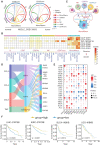CellCall: integrating paired ligand-receptor and transcription factor activities for cell-cell communication
- PMID: 34331449
- PMCID: PMC8421219
- DOI: 10.1093/nar/gkab638
CellCall: integrating paired ligand-receptor and transcription factor activities for cell-cell communication
Abstract
With the dramatic development of single-cell RNA sequencing (scRNA-seq) technologies, the systematic decoding of cell-cell communication has received great research interest. To date, several in-silico methods have been developed, but most of them lack the ability to predict the communication pathways connecting the insides and outsides of cells. Here, we developed CellCall, a toolkit to infer inter- and intracellular communication pathways by integrating paired ligand-receptor and transcription factor (TF) activity. Moreover, CellCall uses an embedded pathway activity analysis method to identify the significantly activated pathways involved in intercellular crosstalk between certain cell types. Additionally, CellCall offers a rich suite of visualization options (Circos plot, Sankey plot, bubble plot, ridge plot, etc.) to present the analysis results. Case studies on scRNA-seq datasets of human testicular cells and the tumor immune microenvironment demonstrated the reliable and unique functionality of CellCall in intercellular communication analysis and internal TF activity exploration, which were further validated experimentally. Comparative analysis of CellCall and other tools indicated that CellCall was more accurate and offered more functions. In summary, CellCall provides a sophisticated and practical tool allowing researchers to decipher intercellular communication and related internal regulatory signals based on scRNA-seq data. CellCall is freely available at https://github.com/ShellyCoder/cellcall.
© The Author(s) 2021. Published by Oxford University Press on behalf of Nucleic Acids Research.
Figures






Similar articles
-
CellCallEXT: Analysis of Ligand-Receptor and Transcription Factor Activities in Cell-Cell Communication of Tumor Immune Microenvironment.Cancers (Basel). 2022 Oct 10;14(19):4957. doi: 10.3390/cancers14194957. Cancers (Basel). 2022. PMID: 36230879 Free PMC article.
-
CPPLS-MLP: a method for constructing cell-cell communication networks and identifying related highly variable genes based on single-cell sequencing and spatial transcriptomics data.Brief Bioinform. 2024 Mar 27;25(3):bbae198. doi: 10.1093/bib/bbae198. Brief Bioinform. 2024. PMID: 38678387 Free PMC article.
-
Exploring the single-cell RNA-seq analysis landscape with the scRNA-tools database.PLoS Comput Biol. 2018 Jun 25;14(6):e1006245. doi: 10.1371/journal.pcbi.1006245. eCollection 2018 Jun. PLoS Comput Biol. 2018. PMID: 29939984 Free PMC article.
-
Supervised application of internal validation measures to benchmark dimensionality reduction methods in scRNA-seq data.Brief Bioinform. 2021 Nov 5;22(6):bbab304. doi: 10.1093/bib/bbab304. Brief Bioinform. 2021. PMID: 34374742 Review.
-
Integrating single-cell and spatial transcriptomics to elucidate intercellular tissue dynamics.Nat Rev Genet. 2021 Oct;22(10):627-644. doi: 10.1038/s41576-021-00370-8. Epub 2021 Jun 18. Nat Rev Genet. 2021. PMID: 34145435 Free PMC article. Review.
Cited by
-
ENTRAIN: integrating trajectory inference and gene regulatory networks with spatial data to co-localize the receptor-ligand interactions that specify cell fate.Bioinformatics. 2023 Dec 1;39(12):btad765. doi: 10.1093/bioinformatics/btad765. Bioinformatics. 2023. PMID: 38113422 Free PMC article.
-
Single-cell pair-wise relationships untangled by composite embedding model.iScience. 2023 Jan 23;26(2):106025. doi: 10.1016/j.isci.2023.106025. eCollection 2023 Feb 17. iScience. 2023. PMID: 36824286 Free PMC article.
-
interFLOW: maximum flow framework for the identification of factors mediating the signaling convergence of multiple receptors.NPJ Syst Biol Appl. 2024 Jun 10;10(1):66. doi: 10.1038/s41540-024-00391-z. NPJ Syst Biol Appl. 2024. PMID: 38858414 Free PMC article.
-
Computational prediction of promotors in Agrobacterium tumefaciens strain C58 by using the machine learning technique.Front Microbiol. 2023 Apr 13;14:1170785. doi: 10.3389/fmicb.2023.1170785. eCollection 2023. Front Microbiol. 2023. PMID: 37125199 Free PMC article.
-
scSDNE: A semi-supervised method for inferring cell-cell interactions based on graph embedding.PLoS Comput Biol. 2025 May 7;21(5):e1013027. doi: 10.1371/journal.pcbi.1013027. eCollection 2025 May. PLoS Comput Biol. 2025. PMID: 40333631 Free PMC article.
References
Publication types
MeSH terms
Substances
LinkOut - more resources
Full Text Sources
Miscellaneous

